From the San Francisco Chronicle which provides an excellent overview of the debate about whether depression is a brain disorder rooted in genetics or not. Read the Story
Depression Is Still a Mystery – We Need a New Model
Happiness is How You Are, Not How You Feel
Aristotle said, “Happiness is the meaning and the purpose of life, the whole aim and end of human existence.” For him and most of his contemporaries, happiness referred not to an emotion but the long-term pattern of action, the sum of which was your moral character. It is the habits of virtue that are acquired over years of exercising the appropriate virtues.
A person doesn’t feel happy as much as happiness is a general state of being. Viewing happiness as something in the world as opposed to an individual feeling is not the way we usually understand the term.
The modern orientation is dominated by individual psychology. But something of the older understanding of happiness as essentially relational still exists in a secondary meaning. For example, we continue to refer to “good times,” or a particular era in a country, or to a happy period in a person’s life. This refers not to feeling happy per se—the kind of happiness that brings a smile to our face—but to a condition that arises in a larger context of actions, conditions, and behavior. To live well is to be good. A happy life is a good life, on this account, and a good life is a virtuous life.
“Happiness is the highest good,” Aristotle wrote. And happiness is realized through the practice of virtue. Happiness casts its gaze outward and is obtainable through the cultivation of moral habits.
The story of beautiful Narcissus is the cautionary tale. He drowns in his own reflection because in his love of himself there is no room for others. For Aristotle, friendship is central to human well-being. Human flourishing isn’t possible without it.
“Friends enhance our ability to think and to act,” Aristotle wrote. This isn’t just any way of thinking or acting but consists of good judgment and virtuous behavior. Friends hold us up to our better selves, directing us toward the good.
You need friends to do good and without them you are likely to fail. It is a failure to be virtuous, and without virtue you can’t be happy. Narcissus drowns because in his self-love there is no one to bring him to develop his moral character.
According to Aristotle, it isn’t good luck or fortune that determines whether you will be happy, although he acknowledges the importance of possessing certain goods as making the attaining of a good life more likely. Friendship, wealth, and power all contribute to a good life.
Conversely, happiness is endangered if you are severely lacking in certain advantages—for example, if you are extremely ugly or disfigured, or have lost children or good friends through death. Tragedy and misfortune hinder human flourishing. This is the impetus behind eliminating social injustices and addressing basic human needs—to open up life’s possibilities even to those beset by bad luck.
Today, I think Aristotle would have added the disadvantage of clinical depression, for, as we now know, this is a bio-chemical illness that is beyond the power of the mind to control through a change of attitude or behavior. Other forms of mental illnesses fall into this category. These are medical issues, not philosophical ones. In addition, I think he would have understood how the subordination of women was contrary to the good life. Parity in terms of power between men and women is necessary for the over-all happiness in society.
Basic needs of nutrition and shelter are necessary for a good life, as is access to knowledge. Good fortune and happenstance play a role in happiness but typically luck isn’t a determining factor. As the work of psychologist Martin E. P. Seligman demonstrates, factors such as money and health account for less than 20 percent of the variance in life satisfaction.
People rise above material circumstances by developing their moral character so that you act virtuously despite the limitations. It is possible to have the disposition to be good most of the time despite the lack of material support.
By Arthur Dobrin, D.S.W.
Sotomayor: Lawyering is a Gift, and Unhappy Lawyers Should ‘Go Back to Square One’
Sotomayor dishes out advice to unhappy lawyers in an article in Oprah Winfrey’s O Magazine. Read the Story
January’s Secret: Recognizing the Challenge
From the site Ms.JD, a piece about how stress, anxiety, depression among law students and attorneys have begun to spark a national dialogue among faculty, staff, and students at many law schools. Read the Story
Study Links Multiple Media Usage to Depression and Anxiety
A new study by Michigan State University found that using multiple forms of media at the same time is linked to symptoms of anxiety and depression. Read the Story
The Worrier Warrior: Working with Depression through Brain Training
Frank walked into my office and said, “I was in therapy for 15 years, know my ‘issues’ inside and out, but I’m still taking an anti-depressant and an anti-anxiety med when I have to do any major presentation at the firm. It’s like my baseline is off. It’s great for being a lawyer. I’m always hyper-vigilant—looking out for the next danger, working very hard to stay on top of everything. But when I get into bed at night, my mind is racing and I feel this sinking feeling. Still, after all this therapy. What can you do for me?”
Frank doesn’t have a motivation problem, or a lack of insight problem. Frank has a brain problem.
Frank had come into my office after having done research into the benefits of neurofeedback for depression and anxiety. I see clients like Frank everyday and I call them my “Worrier Warriors”. Their nervous systems are in a state of ‘activation’ where the flight/fight/freeze brain is always in go-mode. And he’s right—it serves a law firm well. These brains are habitually trained to be on the watch for danger. Add a good analytic mind to that mix and you’ll have a highly successful lawyer who protects his or her clients well, but at a high cost of health and happiness.
We’ve come a long way in our understanding of the brain and brain functioning in producing the symptoms we call anxiety and depression. In the mental health field we used to think of them as ‘mind’ problems, but now we’ve come to understand that they are also brain problems.
We all know we are ‘creatures of habit’ but what that really means is that the brain is prone to habituated rather than fresh responses. The brain functions to be most efficient and effective in use of its energy to protect and maintain the body. The flaw in this system design is that the brain becomes efficient by using cues to approximate the present situation and then uses an old response pattern, which leads to misperceptions of the present moment and less than appropriate responses. We’ve all seen someone “lose it” and respond with an angry outburst when the situation warranted concern or a firm voice.
A dramatic and sad illustration of this principle is the war vet who comes home with Post Traumatic Stress Disorder (PTSD) from his years of service. As a soldier he has been trained to respond to danger with ‘fight’ response. But now he is home from the war and is walking down his hometown street when a car backfires. The brain is habituated to “loud sound equals danger” and the vet’s brain goes into fight mode—yelling, pushes someone or becomes highly irritable and later starts a fight with a loved one.
An important piece of information to know about the part of the brain that operates the fight/flight response: it does not take orders from anyone. It is a part of the brain that needs to be able to respond in milliseconds, so it doesn’t take in information from other, more rational and analytic parts of the brain. As a result you could say to yourself, “I really shouldn’t get angry and fly off the handle.” But the part of the brain that decides that action, acts without input from our rational, willful self. It takes in sensory input and then makes a snap decision.
Why are lawyers so prone to anxiety, depression and anger outbursts? Their brains are habituated to the flight/flight/freeze response (anger/anxiety/depression) response. For whatever reason, and their could be many, they experienced a threat or threats at some point in their lives that were significant enough to habituate the brain to being in this activation mode. A quick way to find out if you are is to ask yourself this question, and answer quickly without thinking: Is the world a safe place? If the answer is ‘no’ then chances are your brain is habituated to thinking that you are in danger when you aren’t. It makes you a perfect candidate to become a lawyer where you always have to be thinking about what the risks are in any situation. Or to be an ENT or an emergency room doctor. Your brain is habituated to perceive risk.
Now what to do about this habituated brain? Here are some tips:
- Breath. Seriously. The breath, slow and deep breathing are ways we can “tell” the brain that we are safe and it can go into a state of relaxation and regulation. Slow deep breathing for 5 minutes where you work your way up to counting to 5 on the inhalation and 5 on the exhalation will do wonders to communicate to the brain to come out of flight/flight and into calm awareness (the state of a regulated and balanced brain.)
- Understand: Help yourself by having a good and clear conceptual understanding that your anxiety and depression and anger outbursts are a brain over-reacting, not an accurate assessment of the present moment’s situation. Your brain is reading a newspaper that’s 20 years old and acting as if it’s the here-and-now news.
- Get exercise: I recently had a neurologist tell me that if the positive effects of exercise (increased heart rate 30 mins 5 times a week) were a drug, it would be considered a “miracle drug” and would generate billions of dollars a year in revenue.
- Get enough sleep. Studies are now coming out showing the detrimental effects of chronic sleep deprivation—5 hours a night or less—on the development of chronic conditions.
- Train the brain with neurofeedback. Neurofeedback trains the brain to optimize its functioning through allowing the brain to ‘see’ its unhelpful response patterns. And the brain learns to use the present moment to decide it’s next action rather than using those old habitual response patterns. As a result the trained brain sleeps better, is calmer, is better able to focus, and is more cheerful. And as one client said, “I have the same problems, they just don’t get to me anymore.”
Natalie Baker, MA LMHC, works as a psychotherapist and neurofeedback trainer in private practice in New York City. http://www.neurofeedbackny.com
Scrooge’s Journey Parallels Real Life-Changing Experiences
Charles Dickens, author of the holiday classic “A Christmas Carol,” gets high marks from researchers who say his portrayal of Ebenezer Scrooge’s switch from miser to saintliness parallels real life-changing experiences. Read the Story
Law School Deans, You Are the Problem
From the blog The Girls Guide to Law School, a post that pins the blame for law student debt on law school deans. Read the Blog
The Tunnel of Depression
Depression makes a person’s world very small and narrow. During a depressive episode, he enters a long tunnel of despair; a dark passageway encasing him in its concrete walls. If he can see an exit, it is in the far distance, a sliver signifying a long and arduous journey ahead.
The tunnel constricts his vitality, his link to the world which isn’t all doom and gloom; where miracles and beauty and goodness are happen, But he cannot see it, cannot perceive the actuality of such events. His reactions to these events is often sadness; a despair borne of his inability to feel the happiness of such things. There is also a sense of hopelessness because the failure to enjoy such things isn’t just temporary. He feels it’s permanent. He will never feel the joy of a great vacation, a heart-felt complement or the glow of a child’s sweet face.
As he travels the tunnel, it can close in on him. He can feel suffocated; that he will die of asphyxiation before he blows out the other side of the tunnel. His breath feels like it is being sucked out of his lungs. He just doesn’t have the stamina to continue. But continue he must, if only on bloodied knees.
As long as you’re on your knees, it might help to pray. Abraham Lincoln, who suffered from depression his entire life, once wrote:
“I have been driven many times to my knees by the overwhelming conviction that I had nowhere to go. My own wisdom, and that of all about me, seemed insufficient for the day.”
Lincoln knew all too well the tunnels of depression. But he kept going, kept persevering. And you will too.
Flashlights can help us in the tunnel as can wise guides or trusted friends; flashlights of skills about how to deal with depression before we go into the tunnel. One of the most important skills is the hard-won knowledge that there is a beginning, a middle and end to our depression — even if we don’t feel this is so at the time. A wise guide can be a therapist who can tell us what to expect and not to listen to the howling winds of depression that blow through the tunnel, to ignore the bats of doubt that live in the recesses of the walls. A trusted friend, can be someone who experiences depression him or herself, but is well enough at the time to walk through the tunnel with you, step by step.
While flashlights don’t light up the whole tunnel, don’t make the depression magically go away, they do provide a beam of concentrated light that burns through that darkness and provides a path, a walkway to an opening that is the end of the experience of a depressive episode.
Often, folks with depression can see the entrance to the tunnel and are heart-struck with a sense of real dread. Having experienced depression before, they know just how bad the journey will be once they’re through the portal. But they are pulled, as if from a rope emanating from the dark reaches of the tunnel, into depression. Attempts to turn around work sometimes.
Sometimes we are strong enough. Sometimes, we have the strength to override the gravitational pull of the tunnel.
But sometimes we don’t. And in this sense, it’s confounding. Because if we can do it sometimes, why can’t we do it all the time? Maybe that’s part of the mystery of depression. Because sometimes, even when armed with the best of skills, we still must enter the tunnel of depression.
But we must always remember the bright light that awaits us on the other side.
Dan’s Top 10 Stress Books
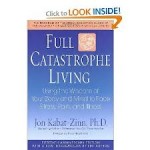 Based on Dr. Jon Kabat-Zinn’s renowned mindfulness-based stress reduction program, this book shows you how to use natural, medically proven methods to soothe and heal your body, mind, and spirit. The title? Oh, that’s from the classic book Zorba the Greek. Zorba is a Greek full of a salty zest for life. At one point, his intellectual benefactor asked him, “Zorba, are you married?” Zorba snorts, “Married? Wife, kids, house . . . the full catastrophe!” When all of our lives are pulled about by the catastrophe of daily living, we need mindfulness to ground us, we need the deep breathing and quiet to enrich the quiets place in all of us.
Based on Dr. Jon Kabat-Zinn’s renowned mindfulness-based stress reduction program, this book shows you how to use natural, medically proven methods to soothe and heal your body, mind, and spirit. The title? Oh, that’s from the classic book Zorba the Greek. Zorba is a Greek full of a salty zest for life. At one point, his intellectual benefactor asked him, “Zorba, are you married?” Zorba snorts, “Married? Wife, kids, house . . . the full catastrophe!” When all of our lives are pulled about by the catastrophe of daily living, we need mindfulness to ground us, we need the deep breathing and quiet to enrich the quiets place in all of us.
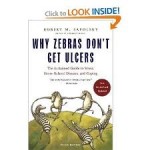 Dr. Robert M. Sapolsky has chapters on how stress affects sleep and addiction, as well as new insights into anxiety and personality disorder and the impact of spirituality on managing stress.
Dr. Robert M. Sapolsky has chapters on how stress affects sleep and addiction, as well as new insights into anxiety and personality disorder and the impact of spirituality on managing stress.
As Sapolsky explains, most of us do not lie awake at night worrying about whether we have leprosy or malaria. Instead, the diseases we fear-and the ones that plague us now-are illnesses brought on by the slow accumulation of damage, such as heart disease and cancer. When we worry or experience stress, our body turns on the same physiological responses that an animal’s does, but we do not resolve conflict in the same way-through fighting or fleeing. Over time, this activation of a stress response makes us literally sick.
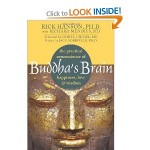 Jesus, Moses, the Buddha, and other great teachers were born with brains built essentially like anyone else’s, but used their minds to change their brains in ways that changed history. With the new breakthroughs in neuroscience, combined with the insights from thousands of years of contemplative practice, this book shows readers how to have greater emotional balance in turbulent times, as well as healthier relationships, more effective actions, and a deeper religious or spiritual practice. It’s full of practical tools and skills readers can use in daily life to tap the unused potential of the brain and rewire it over time for greater peace and well-being.
Jesus, Moses, the Buddha, and other great teachers were born with brains built essentially like anyone else’s, but used their minds to change their brains in ways that changed history. With the new breakthroughs in neuroscience, combined with the insights from thousands of years of contemplative practice, this book shows readers how to have greater emotional balance in turbulent times, as well as healthier relationships, more effective actions, and a deeper religious or spiritual practice. It’s full of practical tools and skills readers can use in daily life to tap the unused potential of the brain and rewire it over time for greater peace and well-being.
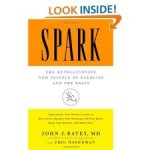 This book offers a fascinating investigation into the transformative effects of exercise on the brain, from the bestselling author and renowned psychiatrist John J. Ratey, MD. Did you know you can beat stress, lift your mood, fight memory loss, sharpen your intellect, and function better than ever simply by elevating your heart rate and breaking a sweat? The evidence is incontrovertible: Aerobic exercise physically remodels our brains for peak performance. This is one of the few books that got me off my ass and into the gym.
This book offers a fascinating investigation into the transformative effects of exercise on the brain, from the bestselling author and renowned psychiatrist John J. Ratey, MD. Did you know you can beat stress, lift your mood, fight memory loss, sharpen your intellect, and function better than ever simply by elevating your heart rate and breaking a sweat? The evidence is incontrovertible: Aerobic exercise physically remodels our brains for peak performance. This is one of the few books that got me off my ass and into the gym.
This is a short book and easy to read. Jan Chozen Bays, M.D., a physician and Zen teacher, has developed a series of simple practices to help us cultivate mindfulness as we go about our ordinary, daily lives. Exercises include: taking three deep breaths before answering the phone, noticing and adjusting your posture throughout the day, eating mindfully, and leaving no trace of yourself after using the kitchen or bathroom. Each exercise is presented with tips on how to remind yourself and a short life lesson connected with it.
The Relaxation and Stress Reduction Workbook
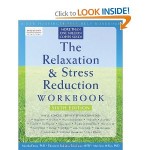 This book details easy, step-by-step techniques for calming the body and mind in an increasingly overstimulated world. It’s based on the latest research, and draws from a variety of proven treatment methods, including progressive relaxation, autogenics, self-hypnosis, visualization, and mindfulness and acceptance therapy. In the first chapter, you’ll explore your own stress triggers and symptoms, and learn how to create a personal plan for stress reduction. Each chapter features a different method for relaxation and stress reduction, explains why the method works, and provides on-the-spot exercises you can do to apply that method when you feel stressed.
This book details easy, step-by-step techniques for calming the body and mind in an increasingly overstimulated world. It’s based on the latest research, and draws from a variety of proven treatment methods, including progressive relaxation, autogenics, self-hypnosis, visualization, and mindfulness and acceptance therapy. In the first chapter, you’ll explore your own stress triggers and symptoms, and learn how to create a personal plan for stress reduction. Each chapter features a different method for relaxation and stress reduction, explains why the method works, and provides on-the-spot exercises you can do to apply that method when you feel stressed.
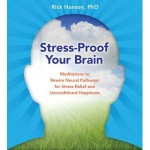 Our brains have evolved powerful tools for coping with threats and danger-but in the face of modern stresses like information overload, money worries, and interpersonal conflicts, our survival reflexes can do more harm than good. To help you adapt your nervous system to the challenges of today’s world, neuropsychologist Dr. Rick Hanson presents Stress-Proof Your Brain. Join him to learn research-based techniques and meditations that will literally re-shape your brain to make you more resilient, confident, and peaceful, including: – How to replace your brain’s unhealthy reactions to stress with protective and self-nurturing responses- Techniques for using memory to soothe and release painful feelings of sadness, guilt, anxiety, inadequacy, or anger – Guided meditations for calming chronic worries, developing gratitude, building inner strength, and more.
Our brains have evolved powerful tools for coping with threats and danger-but in the face of modern stresses like information overload, money worries, and interpersonal conflicts, our survival reflexes can do more harm than good. To help you adapt your nervous system to the challenges of today’s world, neuropsychologist Dr. Rick Hanson presents Stress-Proof Your Brain. Join him to learn research-based techniques and meditations that will literally re-shape your brain to make you more resilient, confident, and peaceful, including: – How to replace your brain’s unhealthy reactions to stress with protective and self-nurturing responses- Techniques for using memory to soothe and release painful feelings of sadness, guilt, anxiety, inadequacy, or anger – Guided meditations for calming chronic worries, developing gratitude, building inner strength, and more.
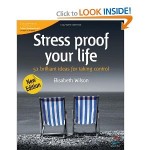 Stress proof your life is for people who struggle to find time for a shower, much less a bath. The ones who worry that stress is affecting their health and relationships. Or they would worry if they weren’t so knackered. Some people are really good at avoiding some stresses without realizing that they are slaves to another kind. Elisabeth Wilson looks at the sources – occupational, genetic and environmental – and reveals 52 brilliant techniques for creating a stress-free zone. When your batteries are blown and burnout is imminent these top tips can help you regain control.
Stress proof your life is for people who struggle to find time for a shower, much less a bath. The ones who worry that stress is affecting their health and relationships. Or they would worry if they weren’t so knackered. Some people are really good at avoiding some stresses without realizing that they are slaves to another kind. Elisabeth Wilson looks at the sources – occupational, genetic and environmental – and reveals 52 brilliant techniques for creating a stress-free zone. When your batteries are blown and burnout is imminent these top tips can help you regain control.
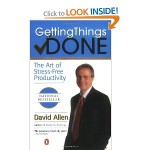 If you’re like me, my biggest source of stress comes from the pressure to get lots of things done everyday.
If you’re like me, my biggest source of stress comes from the pressure to get lots of things done everyday.
In Getting Things Done, veteran coach and management consultant David Allen shares the methods for getting things done. Allen’s premise is simple: our productivity is directly proportional to our ability to relax. Only when our minds are clear and our thoughts are organized can we achieve effective productivity and unleash our creative potential* Apply the “do it, delegate it, defer it, drop it” rule to get your in-box to empty.
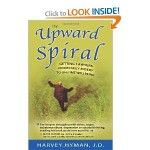 Lawyers help others but take very poor care of themselves. In their quest to max out their earning potential and afford the best material goods our economy has to offer, lawyers lead a narrow, grimly serious existence without emotional rewards. They work inhuman hours yet always feel pressured for time. Since they never stop, breathe, and relax, they are frequently tense, irritable and ready to bark. Author Harvey Hyman, himself a former trial lawyer, gives us the latest science, wit and wisdom in a book I highly recommend.
Lawyers help others but take very poor care of themselves. In their quest to max out their earning potential and afford the best material goods our economy has to offer, lawyers lead a narrow, grimly serious existence without emotional rewards. They work inhuman hours yet always feel pressured for time. Since they never stop, breathe, and relax, they are frequently tense, irritable and ready to bark. Author Harvey Hyman, himself a former trial lawyer, gives us the latest science, wit and wisdom in a book I highly recommend.
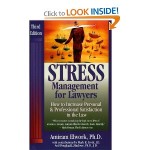 When you practice law, stress comes with the territory. Such stressors as time pressures, work overload, conflict, and difficult people can rob you of a satisfying career and personal life. It doesn’t have to be that way, however. You can take effective action and this book, written specifically for lawyers, shows you how.
When you practice law, stress comes with the territory. Such stressors as time pressures, work overload, conflict, and difficult people can rob you of a satisfying career and personal life. It doesn’t have to be that way, however. You can take effective action and this book, written specifically for lawyers, shows you how.
Built by Staple Creative









